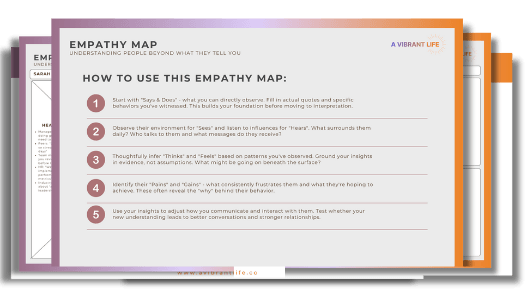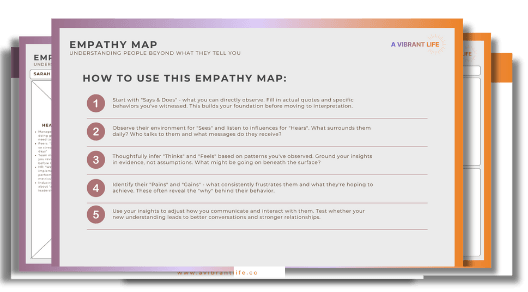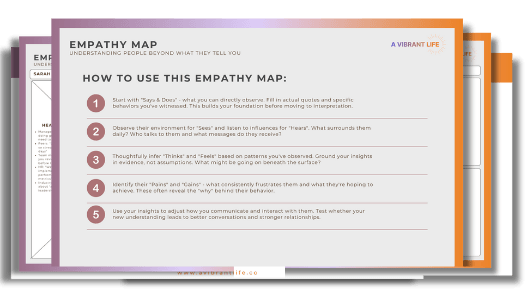The Empathy Map: Understanding People Beyond What They Tell You
Have you ever walked away from a conversation feeling like you completely missed what someone was really trying to say? Or maybe you've been in a meeting where everyone nodded along, but you could sense something wasn't quite right underneath the surface?
This disconnect happens more often than we'd like to admit. People don't always say what they mean, and they definitely don't always mean what they say. The reasons are complicated—social expectations, fear of judgment, not wanting to seem difficult, or sometimes they genuinely don't know how to articulate what they're feeling.
That's where empathy maps come in. They're not about becoming a mind reader or making assumptions about people. Instead, they help you become a better observer of the full human experience—what people say, what they do, what they think, and what they feel. It's about seeing the whole person, not just the polished version they present to the world.
What Is an Empathy Map?
An empathy map is a simple visual tool that captures what you observe and understand about another person across four key areas: what they say, what they do, what they think, and what they feel. The tool also includes sections for their pains (frustrations and obstacles) and gains (wants, needs, and measures of success).
Think of it as creating a more complete picture of someone's experience. Rather than psychoanalyzing or making wild guesses, you're paying attention to the details you might normally miss and organizing those observations in a way that helps you understand their perspective better.
The beauty of an empathy map is its simplicity. You don't need special training or certification to use one effectively. You just need to be curious about other people and willing to look beyond the surface of what they're telling you.
The Four Perspectives: Says, Does, Thinks, Feels
Says
This is the easiest section to fill out because it's what you can directly observe or quote. What does this person actually say in conversations, meetings, interviews, or feedback sessions? These are their literal words, not your interpretation of what they mean.
Does
This focuses on observable behaviors and actions. What do you actually see them doing? How do they spend their time? What are their habits and routines? Sometimes what people do tells a very different story than what they say.
Thinks
This is where you start to read between the lines, but carefully. What might they be thinking but not saying out loud? What beliefs or assumptions might be driving their behavior? This section requires some inference, but it should be grounded in what you've observed, not wild speculation.
Feels
What emotions might they be experiencing? Are they frustrated, excited, worried, hopeful? Again, this requires some thoughtful observation—looking at body language, tone of voice, energy levels, and emotional cues that might not be explicitly stated.
The key is to base your thinking and feeling observations on evidence you can point to, not just hunches.
Pains and Gains: The Driving Forces
Pains represent the challenges, frustrations, and obstacles someone faces. These might be practical problems, emotional struggles, or systemic barriers. Understanding someone's pain points helps you see what's really at stake for them and why certain solutions might feel urgent or important.
Gains capture what someone hopes to achieve or improve. These could be concrete goals, emotional needs, or measures of success that matter to them. Understanding gains helps you see what motivates someone and what would make their life better.
The pains and gains often reveal the "why" behind someone's behavior, even when the behavior itself seems confusing or contradictory.
Why Empathy Maps Matter
It's easy to make assumptions about what people need or want without really understanding their experience. For entrepreneurs and business leaders, this disconnect can be costly—leading to products that miss the mark, team dynamics that stagnate, or client relationships that feel transactional. Empathy maps slow you down and make you more intentional about understanding others, whether they're your customers, employees, or business partners.
Better Client Relationships
When you take time to understand your client's full experience, you can respond more thoughtfully. You might realize that your client's hesitation about a proposal isn't about budget—they're worried about how the change will affect their team's morale and productivity.
More Effective Team Communication
Understanding how your employees think and feel helps you frame your leadership approach in a way they can actually receive. If you know someone is feeling overwhelmed by new systems, you'll approach training and implementation differently than if they're feeling confident and eager for change.
Improved Product Development
Many products fail because entrepreneurs solve for what they think the problem is, not what customers actually experience daily. Empathy maps help you identify the underlying challenges and emotional drivers that your solution needs to address.
Enhanced Leadership and Client Success
Whether you're managing a team, serving clients, or trying to influence organizational change, empathy maps help you understand what will actually motivate and engage the people you're working with. This leads to better outcomes for everyone involved.
How to Create an Empathy Map
1. Choose Your Focus
Start with one specific person whose perspective would significantly impact your business success. This could be a key team member whose engagement affects overall productivity, a major client whose satisfaction drives referrals, or a target customer whose needs represent your broader market. Consider who you need to understand better to achieve your business goals.
2. Gather Your Observations
Spend time observing and listening with business outcomes in mind. What do they actually say in client meetings, team discussions, or feedback sessions? How do they behave during product demos, project updates, or when facing challenges? For entrepreneurs, this might mean sitting in on customer service calls or attending team meetings as an observer. For HR professionals, it could involve shadowing employees during their typical workday or listening to feedback from exit interviews.
3. Fill in the Obvious First
Start with the "Says" and "Does" sections since these are based on direct observation from your business interactions. Be specific and use actual quotes from client calls, team meetings, or performance reviews when possible. Document concrete behaviors you've witnessed during work situations, project collaborations, or customer interactions.
4. Thoughtfully Infer Thoughts and Feelings
For the "Thinks" and "Feels" sections, base your insights on patterns you've observed in business contexts. If an employee consistently asks for detailed timelines during project meetings, they might be thinking about workload management or feeling concerned about meeting deadlines. If a client frequently mentions budget constraints, they might be feeling pressure from their own stakeholders or thinking about ROI justification.
5. Identify Pains and Gains
Look for recurring themes in their professional behavior and communication that impact your business relationship. What consistently frustrates them about current processes, products, or services? What gets them most excited about new initiatives or solutions? For employees, this might reveal workflow inefficiencies or career development desires. For clients, it could uncover unmet needs or success metrics that matter most to their business.
6. Test Your Understanding
The real test of an empathy map is whether it helps you serve your people more effectively. Try adjusting your management approach, client communication, or product features based on your insights. Does employee engagement improve? Do client relationships strengthen? Are conversion rates better? Use business metrics to validate whether your empathy map insights translate into better outcomes.
Common Empathy Map Applications
Team Management
Understanding what really motivates each team member and what challenges they're facing, beyond what they're comfortable sharing directly.
Client Relationships
Getting beneath surface-level feedback to understand what clients actually need and value, which might be different from what they're asking for.
Product Development
Understanding the full experience of your users, not just their functional needs but their emotional journey and underlying concerns.
Conflict Resolution
Seeing beyond the stated positions in a disagreement to understand the underlying needs and concerns of each party.
Change Management
Understanding why people might resist change and what would help them feel more confident about new approaches.
The Reality Check: What Empathy Maps Can't Do
Empathy maps are powerful, but they're not magic. They can't replace actual conversation and feedback. If you really want to understand someone, the best approach is often to simply ask them directly and create space for honest dialogue.
Also, be careful not to turn your empathy map into a fixed judgment about who someone is. People are complex and change over time. What's true in one context might not be true in another.
The goal isn't to become an expert on predicting someone's behavior. It's to become more curious, observant, and thoughtful in how you interact with others.
Making Empathy Maps Work for You
Stay Curious, Not Certain: Use empathy maps to generate hypotheses about someone's experience, not definitive conclusions. Be ready to update your understanding as you learn more.
Focus on Patterns: Look for consistent themes rather than isolated incidents. Someone having a bad day doesn't necessarily reflect their overall experience or perspective.
Use Multiple Perspectives: If possible, get input from others who interact with the same person. Different people might observe different aspects of someone's experience.
Keep It Simple: Don't overcomplicate the process. The most valuable insights often come from paying attention to obvious things you might have been overlooking.
Complete LinkedIn Profile Optimization Checklist - Transform Your Professional Presence Into a Job-Attracting Machine
Transform your LinkedIn profile from overlooked to unforgettable with this comprehensive 50+ checkpoint optimization system. This step-by-step checklist covers everything from professional photo standards to weekly maintenance schedules that actually get you noticed by recruiters. Whether you're aiming for LinkedIn All-Star status or just getting started, this systematic approach ensures every element works together to attract quality opportunities.
Coaching Corner: Facilitating Empathy Map Sessions for Client Understanding
For coaches, managers, and business facilitators, empathy maps create valuable opportunities for helping entrepreneurs and professionals develop deeper understanding of their ideal clients and target customers. This exercise works particularly well after clients have completed tools like the Life Canvas or Life Canvas, which help them clarify who they want to serve.
Session Preparation
Plan for 45-60 minutes for individual sessions, or 90+ minutes for team sessions. Before diving into the empathy map, spend time helping participants identify their target audience or ideal client profile.
Ask them:
"Who do you most want to serve?"
"What type of client gets the best results from your work?"
"Who energizes you when you work with them?"
Prepare participants by explaining the purpose: developing deeper understanding of their ideal clients or target customers to improve service delivery, communication effectiveness, and business relationships. This isn't about understanding everyone—it's about getting crystal clear on the people who are the best fit for what they offer.
For team sessions, establish clear ground rules about confidentiality and respect. Consider starting with individual reflection about their ideal client before moving to group sharing and discussion.
Facilitation Flow
Step 1: Individual Observation (15-20 minutes)
Have participants start with the "Says" and "Does" sections—what they can directly observe. This builds confidence before moving to the more interpretive sections.
Step 2: Thoughtful Inference (20-25 minutes)
Guide participants through the "Thinks" and "Feels" sections with specific questions: "Based on what you've observed, what might they be concerned about?" or "What patterns do you notice in their behavior that might indicate how they're feeling?"
Step 3: Exploring Pains and Gains (15-20 minutes)
Help participants identify underlying motivations and challenges.
Ask:
"What seems to consistently frustrate them?"
"What gets them most engaged or excited?"
Key Facilitation Questions
"What specific behaviors or statements led you to that insight?"
"How might your own perspective be influencing what you're observing?"
"What would you need to learn more about to better understand their experience?"
"How might this understanding change how you interact with them?"
Common Challenges and Solutions
Making Assumptions:
Some participants jump to conclusions without evidence. Remind them to ground their insights in specific observations and to distinguish between what they know and what they're inferring.
Overgeneralization:
Others might create overly broad characterizations. Help them focus on specific contexts and acknowledge that people behave differently in different situations.
Projection:
Watch for participants projecting their own experiences onto others. Guide them to consider perspectives that might be very different from their own.
Judgment vs. Understanding:
Keep the focus on understanding rather than evaluating. The goal is insight, not assessment of whether someone's responses are right or wrong.
Professional Applications
Team Development:
Use for improving team communication and collaboration. Teams that understand each other's perspectives often work more effectively together.
Client Success:
Excellent for understanding client needs and communication preferences. Particularly valuable for identifying unspoken concerns or motivations.
Leadership Coaching:
Helps leaders understand their impact on others and develop more effective approaches to motivation and communication.
Conflict Resolution:
Can reveal underlying concerns and needs that aren't being directly expressed in disagreements.
Making It Stick:
End sessions by having participants identify 1-2 specific changes they'll make in how they interact with the person they mapped. "I learned they value detailed information" becomes "I'll provide more context and background in my communications with them this week."
Schedule follow-up conversations to discuss what they learned and how their interactions changed.
Moving Forward
Empathy maps are ultimately about becoming more human in how we work and live with others. In a world that often rewards quick decisions and surface-level interactions, taking time to really understand someone's experience is both rare and valuable.
Whether you're trying to be a better leader, colleague, partner, or friend, empathy maps provide a structure for the kind of deep listening and observation that builds stronger relationships and more effective collaboration.
The next time you're struggling to understand why someone is responding the way they are, try creating an empathy map. You might be surprised by what you discover—not just about them, but about the assumptions you've been making without realizing it.

About Us
We are a community of practitioners & experts, passionate about empowering individuals & organizations with tools for growth, well-being, and transformation.
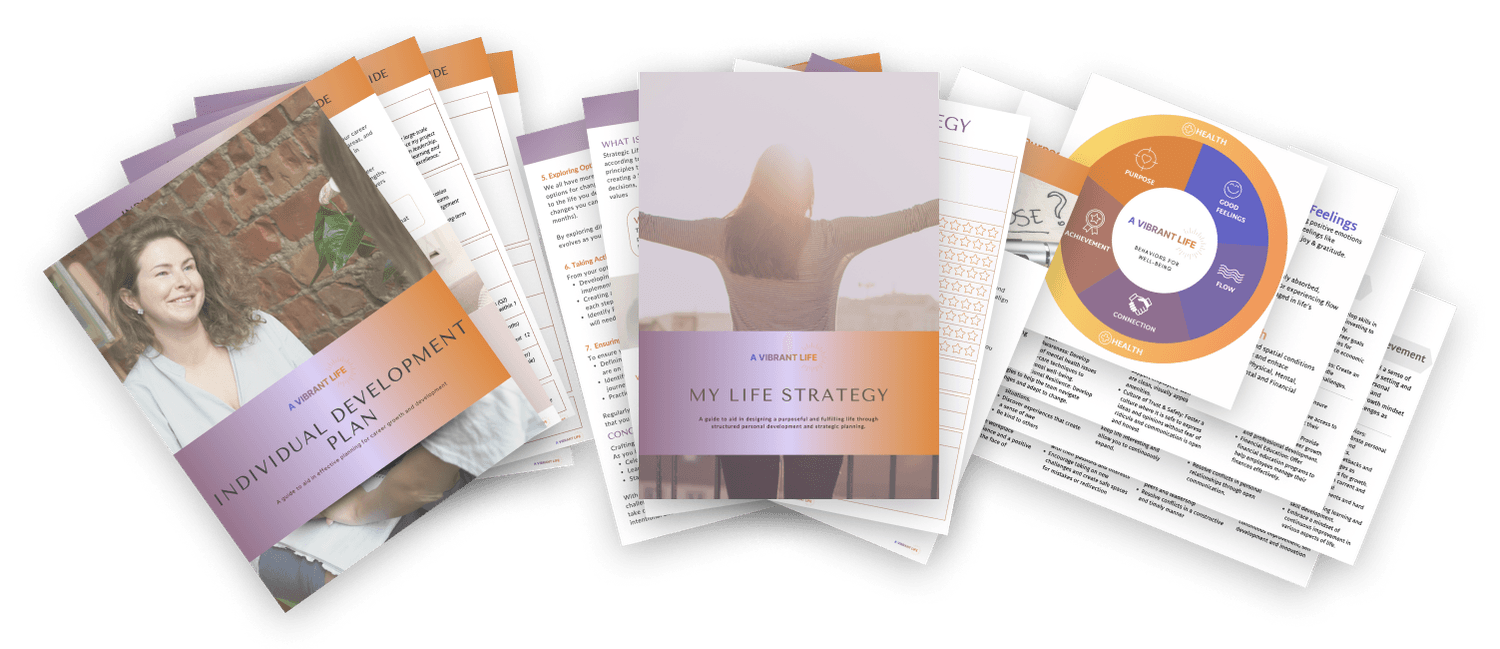
Explore Our Catalog of Transformative Products
Discover our range of expertly crafted products designed to help you achieve your goals and live a more vibrant life. Whether you're looking to advance your career, find balance, or create a thriving environment, our catalog has something for everyone.
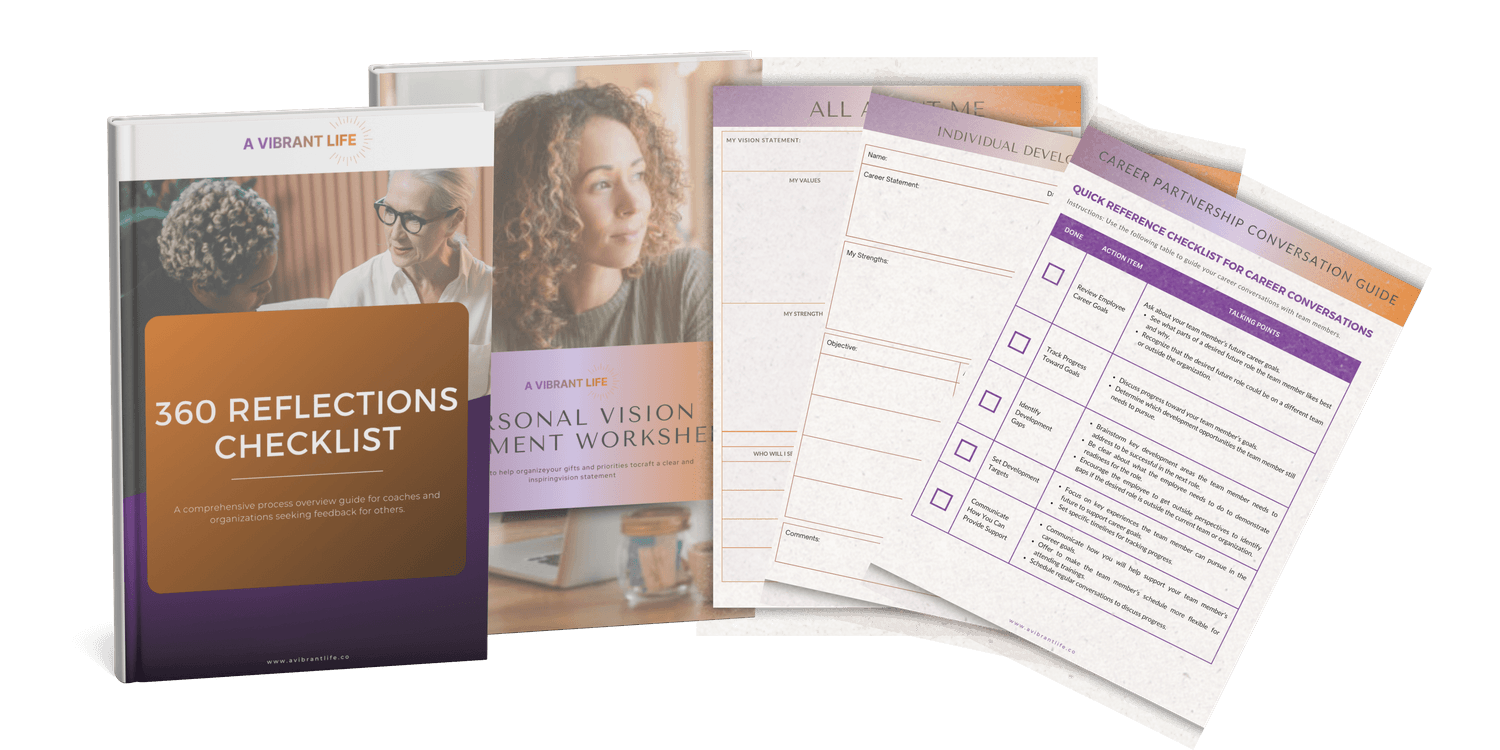
Discover Our Free Resources
Access our collection of valuable free tools, guides, and resources designed to support your personal growth journey. From starter templates to educational content, we're here to help you get started without any cost.
GET EXCLUSIVE ACCESS
Collaborate and Grow with Our HR and Coaching Community
Get exclusive content and resources designed to help you thrive both personally and professionally. Become a member of the A Vibrant Life community and gain access to expert insights, practical strategies, and a supportive network of like-minded individuals.
Your privacy is important to us. We promise to keep your email safe and never spam.

Ready to take the next step towards a vibrant life and fulfilling career?
Explore our transformative solutions tailored to meet you where you are and guide you to where you want to be.

